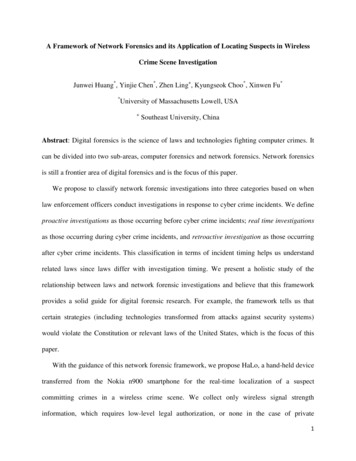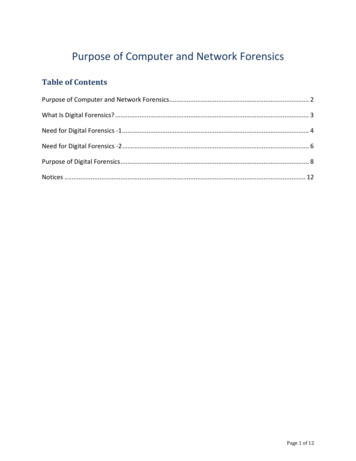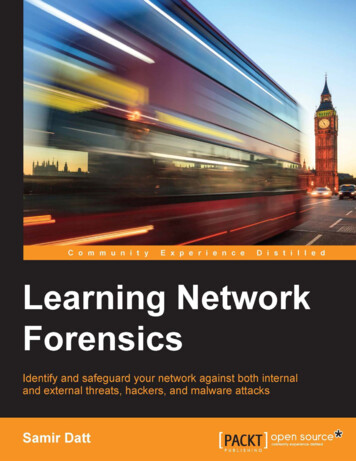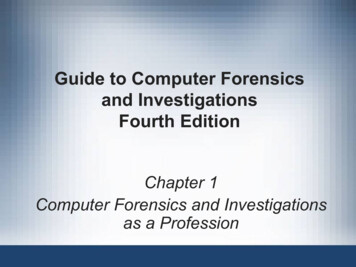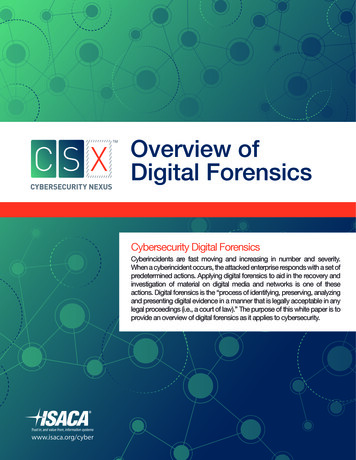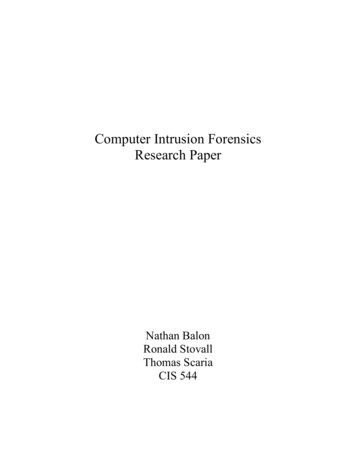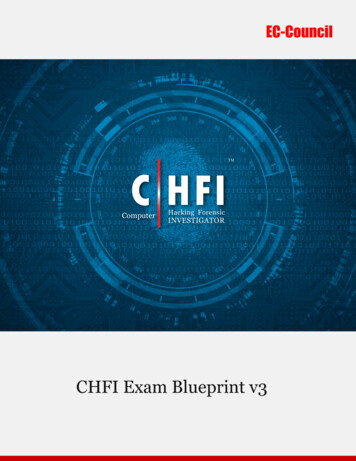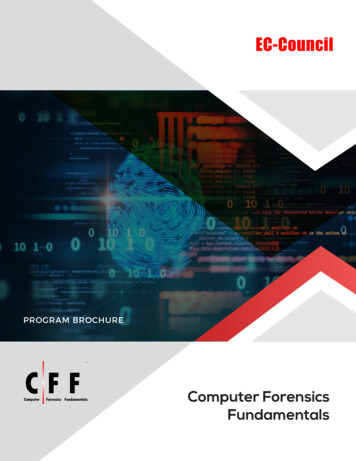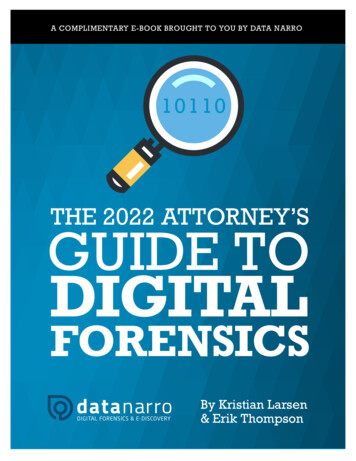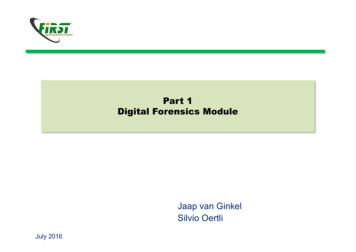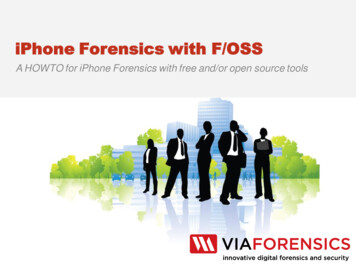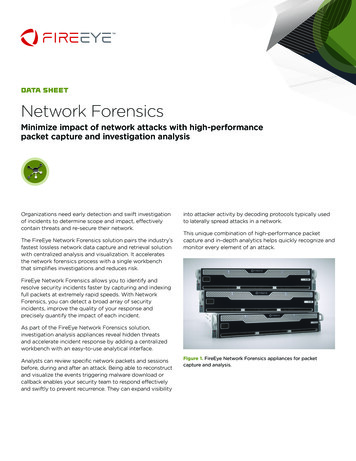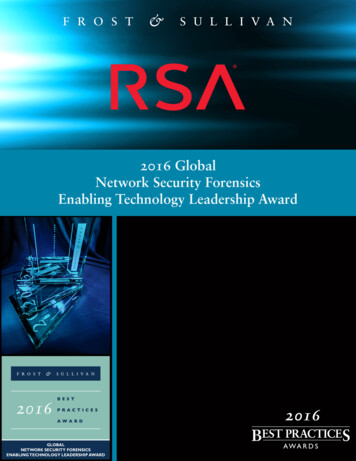
Transcription
2016 GlobalNetwork Security ForensicsEnabling Technology Leadership Award2016GLOBALNETWORK SECURITY FORENSICSENABLING TECHNOLOGY LEADERSHIP AWARD2016
BEST PRACTICES RESEARCHContentsIndustry Challenges . 2Technology Leverage and Customer Impact . 3Conclusion. 6Significance of Enabling Technology Leadership . 7Understanding Enabling Technology Leadership . 7Key Benchmarking Criteria . 8Best Practice Award Analysis for RSA, The Security Division of EMC . 8Decision Support Scorecard . 8Technology Leverage . 9Customer Impact . 9Decision Support Matrix . 10The Intersection between 360-Degree Research and Best Practices Awards . 11Research Methodology . 11About Frost & Sullivan . 12 Frost & Sullivan 20161“We Accelerate Growth”
BEST PRACTICES RESEARCHBackground and Company PerformanceIndustry ChallengesThe network security team at Frost and Sullivan views Advanced Persistent Threat (APT)defense as not a singular technology, but rather as a collection of technologies used inconcert. Network security forensics is the requisite technology used when a suspectedsecurity breach has occurred.The difference between a security incident and a breach issubtle and may be a matter of semantics, but is necessaryto establish to explain the capabilities of network securityforensics tools. A security incident occurs anytime adetective system creates an alert. The majority of securityincidents are not an indication of a breach, but of coursethis can’t be confirmed without an investigation. An alarmcould be raised when an end user is using or consuming anunusual amount of bandwidth, an endpoint device isconnecting to a server outside of its normal region, or aserver reconfiguration is taking place outside of normalpractices, as well as many other indicators of compromise.Rightly these incidents are cause for investigation but in fact may turn out to be benign.A validated security breach requires three conditions to be met: A breach is the establishment of an unapproved presence (potentially malicious)within a proprietary network. The end user’s system or credential, or aspects of the enterprise network has beenexploited, which often leads to data exfiltration outside of the enterprise. A forensics investigation has to be initiated to run the issue to ground. A networksecurity forensics investigation occurs when an exploit becomes known to anIT/Security team as a result of a material and malicious change somewhere on theenterprise network.Today, the tools that are often used to protect networks are often the same tools used todetermine what happened in a breach. This is problematic for these preventive focusednetwork security platforms. One example of the problem is if malware 1 did defeat thepreventive security system, the vendors offering the forensics tool are asking securityteams to use the same tools that ostensibly “failed” in the first place. However, more1Part of the problem with the term “breach” is the term is broadly used in network security.Breach is almost synonymous with malware and phishing attacks. In fact, breaches canoccur without the use of malware when servers are being reconfigured, passwords andcredentials are stolen, or a theft of physical equipment happens. In these cases, the breachsituation is not caused by a failing in a preventive security tool; nonetheless, the breachmust be detected, understood, and remediated. Frost & Sullivan 20162“We Accelerate Growth”
BEST PRACTICES RESEARCHmature security organizations understand the limitation of prevention and are increasinglyfocusing on systems and processes to improve their detection and response capabilities.RSA Security Analytics is cited in this award for its ability to support investigationsleveraging network flow data, full packet capture (PCAP), logs, and endpoint data as wellas information from other security platforms and external threat intelligence sourcesproviding world class network security forensics.In addition, but not the focus of thisparticular award, RSA Security Analytics provides Advanced Network Monitoring &Analytics capabilities as well as part of an integrated threat detection and responsesolution.Technology Leverage and Customer ImpactRSA has long been a leader in network security technology. RSA offers products andservices for authentication, identity management & governance, data protection, advancedsecurity operations, network and endpoint monitoring and analytics, and for themanagement of governance, risk and compliance. The RSA Security Analytics product isdelivered via the combination of a scalable server, storage, and security data collectionarchitecture providing advanced detective analytics, forensic investigations, reporting,incident management, and threat intelligence correlation via an integrated platform.Commitment to InnovationThe RSA Security Analytics platform is comprised of two primary elements: the captureinfrastructure and the analysis, investigation, and data retention infrastructure. See RSASecurity Analytics for more details on this. This distributed architecture provides SecurityAnalytics several important capabilities: Platform versatility, scalability, and flexibility. The capture and analyticsinfrastructure of Decoders, Concentrators, Analytic Servers, Event Stream Analysis(ESA) Servers, and Archivers can be deployed using just a handful of appliances orvia many dozens of systems in highly distributed, global deployment – scaled up ordown to meet the performance needs of the organization. In addition RSA SecurityAnalytics can be deployed virtually in part or in whole. Unified analytics. The ESA server provides detective analytics leveragingmetadata from logs/events, network packets, NetFlow, endpoint data, threatintelligence, and other context data.The ESA server can apply both traditionalcorrelations as well more sophisticated data science based techniques to detect andalert on security anomalies. ingestiontechnology to simultaneously tag and enrich data for threat indicators while parsingthe raw data into metadata for further detective analytics as well as to supportforensic and investigative uses. In a forensics investigation the use of thismetadata without losing connection to the raw data is critical to finding the “rootcause” of the event.The collection of the raw data for extended periods alsoenables Security Analytics to recreate full sessions (Web browsing, FTP, email etc.)so that the investigating security analysts can literally “see” what happened. Frost & Sullivan 20163“We Accelerate Growth”
BEST PRACTICES RESEARCH Golden image and whitelisting. If Security Analytics and ECAT (RSA’s endpointdetection and response tool) are used concurrently, all new file insertions into thenetwork (via Security Analytics) and onto monitored endpoints (via ECAT) can beanalyzed statically as well as dynamically. If a file is found to be secure, it can beadded to ECAT’s and Security Analytics’s whitelists and be trusted from that pointforward.Cyber security platforms such as vulnerability management (VM), firewalls and intrusiondetection and prevention systems (IDS/IPS) generally depend upon file signatures todetect malware and other security relevant activity. Security Analytics does not depend onsignatures; it uses multiple analytic techniques that are focused on detecting anomalousbehavior at both lower (such as at the protocol level) and higher levels (such as at theWeb domain level) of the IT stack. RSA ECAT, a closely integrated technology with RSASecurity Analytics, also provides a signature-less threat detection system that uses agentson endpoints (servers & clients) to look for anomalous behavior & malware across theenterprise at both the user and kernel level of the host.Commitment to CreativityFrost & Sullivan insists on at least partial, but preferably full packet capture or PCAP as aqualification to be considered as a network security forensics platform. The selection ofthis attribute excludes tools or tool sets that rely only on NetFlow as the data source forforensics investigations.In one camp, a new class of network forensics tools is being developed that rely on theextraction of packet headers only, combined with metadata correlation. This approach isattractive from a storage perspective as packet headers consume between 1‒10% of thestorage space as do full PCAP based systems.However, the efficacy of full packet captureis difficult to argue against as this nt and context, as well as fullsession reconstruction on their platforms.Keyadvantagestoorganizationsusingnetwork security forensics with full ity (including east-west traffic), morecomplete metadata, full packet analysiswhich may be necessary to see where badcode is embedded in the malware or whenprotocols are malformed (see graphic tothe left).When deep security monitoring capabilities and performance are the key criteria, vendorsoffering network security forensics with full packet capture, such as RSA, increasingly winthe business. Frost & Sullivan 20164“We Accelerate Growth”
BEST PRACTICES RESEARCHApplication DiversityPerhaps the most underappreciated aspect of a good network forensics tool is the manhours that can be saved. Frost & Sullivan believes that 50—70% of the time to investigatea security incident is in triage. In journalism, the emphasis is on the 4 Ws (who, what,where, and when). The four Ws can be used in security operations, but with two addedcaveats. The first caveat is that by definition a network security event is triggered when abreach is likely to have occurred; time is really of the essence. Secondly, the mosteffective correlations and analytics use more than just one security event to estimate theimportance of the security incident. An attack may be designed to exploit a specific OS,application, user group, or file type and often will exploit many systems and points ofentry at the same time. Investigations cannot be limited to one specific area of a networkor system; rather, a threat is best contained to the degree that the infection/exfiltration isdiscovered on all systems that are affected. With today’s more targeted attacks, attackersoften have multiple points of entry into the organization. If you don’t find them all youhaven’t sufficiently mitigated the threat.RSA Security Analytics is ahead of the curve in creating advantages for securityinvestigation teams: Native incident management. A security incident is centrally managed and thuscan be investigated by several analysts concurrently or in sequence. Metadata. The RSA Security Analytics generates, analyzes, and makes availablefor investigations of more than 175 metadata fields. Metadata is automaticallyenriched with threat intelligence. No matter what the source of data, logs, events,Netflow, packet capture, or other, the same metadata model is used. This avoidsthe problem of data silos thus helping security analysts to more easily connect thedots during an investigation. Session replay. RSA Security Analytics can replay whole suspect sessions (Web,FTP, email, etc.) as well as provide a view of exactly what was exfiltrated in apotential attack. Furthermore, short, intermediate, and long time period searches,reports, and analytics can be conducted as well Data science. RSA Security Analytics uses data science and machine learning tobetter detect threats and guide the priority of forensic investigations.Brand EquityThe origin of RSA is in 1979—the RSA acronym stands for the Rivest-Shamir-Adlemancryptosystem that is used in public key encryption systems even today. RSA has a stronghistorical affiliation with state-of-the-art technology.The current RSA incident detection and network forensics platform, RSA Security Analyticswith RSA ECAT for the endpoint, is a combination and evolution of several well-reputedpredecessor products. In April 2011, RSA acquired NetWitness. NetWitness provided RSAwith packet decoding, network visibility, and an investigation platform.EMC, RSA’s parent company, had worked with Silicium Software for several years toprovide endpoint detection and investigation capabilities for EMC’s CIRC. In September Frost & Sullivan 20165“We Accelerate Growth”
BEST PRACTICES RESEARCH2012, RSA acquired Silicium Software and its key ECAT endpoint threat detection andresponse technology. To provide a genuinely unique security platform, RSA has integratedSecurity Analytics and ECAT to provide a unified network and endpoint monitoring andinvestigation solution.The RSA Security Analytics platform receives fresh threat intelligence information andother content continuously through its RSA Live service, which is included with theproduct. The RSA Live content delivery service dynamically updates the components ofSecurity Analytics with threat information as it is discovered by RSA Research teams aswell as those of 3rd parties. This makes this threat intelligence actionable immediately aspart of the Security Analytics system.ConclusionNetwork security is not just for the detection of malware; it involves the detection andinvestigation of security incidents using multiple forms of telemetry as well as multipleforms of analytics. With Security Analytics, RSA is able to bring a comprehensive set oftechnologies to incident detection and network security forensics. Metadata generationand full packet capture gives Security Analytics depth and real-time visibility to determinethe security posture of the enterprise as inbound and outbound communications aretraversing its network.With its strong overall performance, RSA with RSA Security Analytics has earned Frost &Sullivan’s 2016 Network Security Forensics Enabling Technology Leadership Award. Frost & Sullivan 20166“We Accelerate Growth”
BEST PRACTICES RESEARCHSignificance of Enabling Technology LeadershipUltimately, growth in any organization depends upon customers purchasing from yourcompany, and then making the decision to return time and again.In a sense, then,everything is truly about the customer—and making those customers happy is thecornerstone of any long-term successful growth strategy. To achieve these goals throughtechnology leadership, an organization must be best-in-class in three key areas:understanding demand, nurturing the brand, and differentiating from the competition.Understanding Enabling Technology LeadershipProduct quality (driven by innovative technology) is the foundation of delivering customervalue. When complemented by an equally rigorous focus on the customer, companies canbegin to differentiate themselves from the competition. From awareness, to consideration,to purchase, to follow-up support, best-practice organizations deliver a unique andenjoyable experience that gives customers confidence in the company, its products, andits integrity. Frost & Sullivan 20167“We Accelerate Growth”
BEST PRACTICES RESEARCHKey Benchmarking CriteriaFor the Enabling Technology Leadership Award, Frost & Sullivan analysts independentlyevaluated two key factors—Technology Leverage and Customer Impact—according to thecriteria identified below.Technology LeverageCriterion 1: Commitment to InnovationCriterion 2: Commitment to CreativityCriterion 3: Stage Gate EfficiencyCriterion 4: Commercialization SuccessCriterion 5: Application DiversityCustomer ImpactCriterion 1: Price/Performance ValueCriterion 2: Customer Purchase ExperienceCriterion 3: Customer Ownership ExperienceCriterion 4: Customer Service ExperienceCriterion 5: Brand EquityBest Practice Award Analysis for RSA, The Security Divisionof EMCDecision Support ScorecardTo support its evaluation of best practices across multiple business performancecategories, Frost & Sullivan employs a customized Decision Support Scorecard. This toolallows our research and consulting teams to objectively analyze performance, according tothe key benchmarking criteria listed in the previous section, and to assign ratings on thatbasis. The tool follows a 10-point scale that allows for nuances in performance evaluation;ratings guidelines are illustrated below.RATINGS GUIDELINESThe Decision Support Scorecard is organized by Technology Leverage and CustomerImpact (i.e., the overarching categories for all 10 benchmarking criteria; the definitionsfor each criteria are provided beneath the scorecard).The research team confirms theveracity of this weighted scorecard through sensitivity analysis, which confirms that smallchanges to the ratings for a specific criterion do not lead to a significant change in theoverall relative rankings of the companies. Frost & Sullivan 20168“We Accelerate Growth”
BEST PRACTICES RESEARCHThe results of this analysis are shown below. To remain unbiased and to protect theinterests of all organizations reviewed, we have chosen to refer to the other key playersas Competitor 2 and Competitor 3.DECISION SUPPORT SCORECARD FOR ENABLING TECHNOLOGY LEADERSHIP AWARDMeasurement of 1–10 (1 poor; 10 excellent)Enabling Technology atingRSA9.59.99.7Competitor 28.06.07.0Competitor 35.87.06.4Technology LeverageCriterion 1: Commitment to InnovationRequirement: Conscious, ongoing adoption of emerging technologies that enables newproduct development and enhances product performancesCriterion 2: Commitment to CreativityRequirement: Technology is leveraged to push the limits of form and function, in thepursuit of “white space” innovationCriterion 3: Stage Gate EfficiencyRequirement: Adoption of technology to enhance the stage gate process for launching newproducts and solutionsCriterion 4: Commercialization SuccessRequirement: A proven track record of taking new technologies to market with a high rateof successCriterion 5: Application DiversityRequirement: The development and/or integration of technologies that serve multipleapplications and can be embraced in multiple environmentsCustomer ImpactCriterion 1: Price/Performance ValueRequirement: Products or services offer the best value for the price, compared to similarofferings in the marketCriterion 2: Customer Purchase ExperienceRequirement: Customers feel like they are buying the most optimal solution thataddresses both their unique needs and their unique constraintsCriterion 3: Customer Ownership ExperienceRequirement: Customers are proud to own the company’s product or service, and have apositive experience throughout the life of the product or service Frost & Sullivan 20169“We Accelerate Growth”
BEST PRACTICES RESEARCHCriterion 4: Customer Service ExperienceRequirement: Customer service is accessible, fast, stress-free, and of high qualityCriterion 5: Brand EquityRequirement: Customers have a positive view of the brand and exhibit high brand loyaltyDecision Support MatrixOnce all companies have been evaluated according to the Decision Support Scorecard,analysts can then position the candidates on the matrix shown below, enabling them tovisualize which companies are truly breakthrough and which ones are not yet operating atbest-in-class levels.DECISION SUPPORT MATRIX FOR ENABLING TECHNOLOGY LEADERSHIP AWARDHighCustomer ImpactAwardRecipientCompetitor 3Competitor 2LowLow Frost & Sullivan 2016Technology Leverage10High“We Accelerate Growth”
BEST PRACTICES RESEARCHThe Intersection between 360-Degree Research and BestPractices AwardsResearch hodology represents the analytical rigorof our research process. It offers a 360-360-DEGREE RESEARCH: SEEING ORDER INTHE CHAOSdegree-view of industry challenges, trends,and issues by integrating all 7 of Frost &Sullivan's research methodologies. Too often,companies make important growth decisionsbased on a narrow understanding of theirenvironment,leadingtoerrorsofbothomission and commission. Successful ,thoroughtechnical,economic, financial, customer, best practices,and demographic analyses. The integration oftheseresearchdisciplinesintothe360-degree research methodology provides anevaluationplatformforbenchmarkingindustry players and for identifying thoseperforming at best-in-class levels. Frost & Sullivan 201611“We Accelerate Growth”
BEST PRACTICES RESEARCHAbout Frost & SullivanFrost & Sullivan, the Growth Partnership Company, enables clients to accelerate growthand achieve best in class positions in growth, innovation and leadership. The company'sGrowth Partnership Service provides the CEO and the CEO's Growth Team with disciplinedresearch and best practice models to drive the generation, evaluation and implementationof powerful growth strategies. Frost & Sullivan leverages almost 50 years of experience inpartnering with Global 1000 companies, emerging businesses and the investmentcommunity from 31 offices on six continents. To join our Growth Partnership, please visithttp://www.frost.com. Frost & Sullivan 201612“We Accelerate Growth”
The current RSA incident detection and network forensics platform, RSA Security Analytics with RSA ECAT for the endpoint is a combination, and evolution of several well-reputed predecessor products. In April 2011, RSA acquired NetWitness. NetWitness provided RSA with packet decoding, network visibility, and an investiga tion platform.
